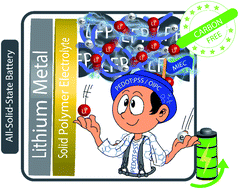Mixed ionic and electronic conducting binders containing PEDOT:PSS and organic ionic plastic crystals toward carbon-free solid-state battery cathodes†
Abstract
The performance of next generation solid-state lithium metal batteries (LMBs) is intimately related to the ionic-electronic interconnection within the cathode material. In batteries containing liquid electrolytes, the soaking of the electrolyte and the addition of carbon provide sufficient ionic and electronic conductivity through the cathode. However, in solid-state systems, cathodes are completely dry, and thus, they lack mobile Li ions and good electronic interconnection. Organic mixed ionic-electronic conductors (OMIECs) are promising binders to provide that interconnection through a compact carbon-free cathode. However, most of the OMIECs have been developed based on solvent swelling of conducting polymers or combining with ionic liquids as composites. These options are not the most adequate ones for LMBs due to liquid-related issues such as leakage. Here, a novel approach towards all-solid-state OMIECs is presented by combining PEDOT:PSS and different organic ionic plastic crystals (OIPCs): C2mpyrFSI and C2mpyrTFSI, obtaining a synergistic effect with higher ionic and electronic conductivities than those of the neat materials (σelectronic of 580 S cm−1 and σionic of 3.7 10−5 S cm−1 at 70 °C). These outstanding values for all-solid state OMIECs resulted from highly ordered conducting pathways as demonstrated by XRD and AFM. The optimum composition with respect to electronic and ionic conductivity (80/20 PEDOT:PSS/C2mpyFSI) was subsequently tested, for the first time, as a binder in a LiFePO4 cathode formulation in a carbon-free solid-state battery. The solid-state Li|LiFePO4 cell with the OMIEC binder showed an enhanced discharge capacity (157 mA h g−1 at C/10) and improved rate capability, in comparison to a solid-state cathode formulation using an ionic conducting polymeric binder and carbon additive. A specific capacity of 145.5 mA h g−1 at C/2 rate was achieved with an excellent capacity retention of 99.7% (145.2 mA h g−1) after 500 cycles.

- This article is part of the themed collections: Celebrating International Women’s Day: Women in Materials Science, 2022 Journal of Materials Chemistry A Most Popular Articles, 10th Anniversary: Most popular articles, Journal of Materials Chemistry A Emerging Investigators and Editor’s Choice: Beyond Li: Alternative battery chemistries


 Please wait while we load your content...
Please wait while we load your content...